This guy just might be good.
Auston Matthews put on a show as the Toronto Maple Leafs defeated the Montreal Canadiens by a final score of 5-3. It was another dazzling offensive display, which we’ll be sure to break down in extra detail tonight.
Montreal played a strong game at even strength, winning the territorial battle. Thanks to a few brilliant moments from their best player and a three-for-four night on the power play, Toronto was able to come out with the win. A one-game sample obviously isn’t enough to answer the “stars vs. system” debate, but on nights like these, you sure like having the high-end talent.
I’m excited to break this one down. Let’s dive into it!
5 Stars
Game Puck: Auston Matthews (C, #34) — It was a four-point night for Matthews, so buckle up, we’ve got some tape to break down.
After Toronto failed to gain the zone three separate times on a 5-on-3 to start the 2nd period, all they needed was one pass across from Mitch Marner.
Carey Price reads it well and Matthews is still able to beat him over the shoulder. That’s just not fair.
On his next shift, #34 bats down a failed icing attempt by Jeff Petry and creates a 2-on-1 for Joe Thornton, who doesn’t miss Travis Boyd backdoor.
Matthews created another 2-on-1 later in the game by taking a hit from Shea Weber to make a play.
On his fourth point of the night, Matthews beat Price clean from the top of the circle with a wrist shot.
Much like an elite pitcher in baseball, the best shooters in hockey are able to disguise their release. Just when you think you’re getting a fastball outside, they throw you a changeup inside.
That gives Matthews 18 goals in 18 games, which is starting to get everyone excited.
Auston Matthews is the first NHL player to have 18 goals in the first 18 games in 15 years.
— James Mirtle (@mirtle) February 21, 2021
I hate to be the nerd who says his 22.5 percent shooting percentage is unsustainable, but we’re talking about a career 16 percent shooter. Steven Stamkos shot 20 percent in his 60-goal season. Why can’t Matthews?
50 in 50 seems undoable in the modern NHL, but Matthews is reaching the point where 45 seems completely within reason. If you throw in a few bounces here and there, maybe it’s not completely impossible.
As a final note on Matthews, the fact that he’s accomplishing all of this offensively while providing big-time value defensively is what stands out to me.
From @MikeKellyNHL, some non-goal stats on Matthews. He’s on another level all over the rink so far this season. pic.twitter.com/OePnuDuLRE
— Justin Bourne (@jtbourne) February 21, 2021
We don’t see elite goal scorers impact the game this well defensively — it just hasn’t happened historically in this league.
What Matthews is doing right now is special. Remember that when you’re watching him this season.
Frederik Andersen (G, #31) — Matthews started to get rolling in the second period, but Andersen was Toronto’s best player by far in the game’s first 20 minutes. He was forced to stop a breakaway by Tomas Tatar, as well as a few dangerous opportunities on the penalty kill.
His best save of the night came on a 2-on-1 that could have tied the game for Montreal.
This game made me start to think about Andersen’s play this year. His save percentage isn’t as high as you’d expect, but when you remember that every goalie’s save percentage is down this year, Andersen actually compares favourably to his peers.
Freddy Andersen's played more than any goalie this season & 5-on-5 he's faced the most shots, leads the league in high danger shots/saves + he's 4th/26 in SV% among those who've started 9 or more games.
Narratives are fun, but right now he should be getting nothing but respect.
— JD Bunkis (@JDBunkis) February 21, 2021
With the exception of last season, Andersen has consistently been a top 10 goaltender in the NHL. The evidence suggests he’s in that range again this year, and honestly, should we really be shocked?
4 Stars
Mitch Marner (RW, #16) — He’s starting to gain more confidence in his wrist shot.
That’s the second time this week Marner has walked into the slot and beat the goaltender clean. We’ve all made fun of his shot before, especially his one-timers on the power play, but if you want to get more assists, you need to scare the defense with the threat of a shot.
Marner’s clearly been working on that part of his game and it’s starting to look much more threatening, which should open up more ice for his elite passing ability.
Alex Kerfoot (LW, #15) — He’s looked much better when he plays left wing this season. Now, it obviously helps to play with Tavares-Nylander, but I’ve found that Kerfoot is using his speed more effectively on the wing.
He’s been able to win more puck races lately with his speed streaking down the wing. Kerfoot also did a great job of turning pucks over in the neutral zone defensively in this game.
Zach Bogosian (RD, #22) — It hurts to say this, but Travis Dermott didn’t play very well tonight. Zach Bogosian had to cover for him quite a bit in transition defense and actually did a great job. He also used his size really well on puck retrievals, hammering forecheckers into the boards with clean but effective hits.
3 Stars
Jake Muzzin (LD, #8) — This one was not clean.
Jake Muzzin and Josh Anderson were getting into it all night. They shared the ice for 7:31 at even strength and most of it looked like this. That’s a lot of punishment to take and still focus on making the next play.
Considering Justin Holl had his worst game of the season, I thought Muzzin handled everything pretty well. He wasn’t dealt the greatest hand after all.
The Mikheyev-Engvall-Hyman Line — I saw that line combination before the game and thought “Man, those three would suck to play against.” They lived up to the hype. Zach Hyman was all over the ice, helping his team secure possession by winning pucks back.
Pierre Engvall was able to skate the puck up the ice a couple of times, but there seems to be a ceiling on what he can accomplish offensively after crossing the blue line. There have been so many times this season a perfect pass has sailed past him in the slot.
Those are the high-percentage chances teams are trying to create in the modern game; a pass through the middle of the ice after gaining the zone. This is obviously only one isolated incident, but it’s been happening a lot to Engvall. At some point, that isn’t a coincidence.
Speaking of players not finishing on quality chances, here was Ilya Mikheyev‘s best play of the game.
Players like Mikheyev always confuse me. Is it a lack of true finishing talent or this guy just getting jobbed by the shooting percentage gods? I want to say the answer lies somewhere in between.
Jason Spezza (RW, #19) — After getting hemmed in his own end for most of the game alongside Jimmy Vesey & Co, the Leafs moved Spezza up to the Kerfoot-Tavares line and it seemed to go pretty well.
Spezza has been excellent on Toronto’s second power play for well over a year now. He produces at an elite rate for a bottom-six forward. Can we please get him a better linemate than Vesey?
TJ Brodie (RD, #78) — The difficulties of playing with Morgan Rielly will be outlined in the 1-star section. For now, I’d just like to say that Brodie made good decisions with the puck for the most part on Saturday night. Defensively, there were some issues, but again, I’d argue that was mostly on his partner.
2 Stars
William Nylander (RW, #88) — Oh boy.
After an awesome first period where Nylander was flying at even strength, he stopped skating in the back-half of the game and was punished for it by his head coach. Sheldon Keefe didn’t play Nylander in the final nine minutes of the game.
I’m not here to re-hash the tired debate on this topic, I’m simply here to evaluate how Nylander played tonight. He was electric for 20 minutes, which is the player I’ve grown to love as a hockey analyst.
John Tavares (C, #91) — This was another mostly quiet night for Tavares, which has been happening more than you’d expect this season. He did pick up a secondary assist off of a nice pass from the wall in the defensive zone to start the breakout, but this is John Tavares we’re talking about.
We’ve come to expect a player of his calibre to make more game-changing plays offensively.
Travis Boyd (C, #72) — As happy as I was to see that the Travis Boyd PDO bender is still in full effect, it’s worth noting he was responsible for 1.5 breakaway goals against.
I say half because Rielly was partially to blame on one of them. On the other, Boyd simply turned the puck over at the offensive blue line to Paul Byron, and it was off to the races from there.
Where I come from, scoring a goal that Matthews and Thornton created for you doesn’t undo the damage of giving up multiple breakaways.
Joe Thornton (LW, #97) — The Thornton-Matthews-Marner line was fantastic again, but how much of that was actually because of Thornton tonight? In previous games, he’s made a big impact by winning pucks back low in the offensive zone and finding his star players in open space.
Tonight, I didn’t see much of that. He did get a couple good scoring chances, although those were created for him by his teammates.
Travis Dermott (LD, #23) — As a long-time Travis Dermott truther, even I can admit when he doesn’t play well. There a few good plays he made to start the breakout, but that was undone by his poor play defensively.
1 Star
Morgan Rielly (LD, #44) — Here’s the frustrating part about Rielly; he had two assists tonight and I’m still not convinced he played well. After watching Brodie jump up in the play, Rielly didn’t cover as the last defenseman back and gave up a breakaway. In Rielly’s defense, some F3 support from Travis Boyd would’ve been nice on that play.
Overall, I find myself asking why does Rielly keep getting outshot at even strength? After 19 games and over 359 minutes, he’s still below 50% in shot share (CF%) this season. That shouldn’t be happening to the minutes leader of a team that wants to be considered a Stanley Cup contender.
Jimmy Vesey (LW, #26) — He was able to break up plays defensively with his long stick, but he couldn’t transition the puck out of his end at all. It’s why he spent so much time stuck in the defensive zone.
Justin Holl (RD, #3) — Woof.
NHL defensemen have these nights – remember when TJ Brodie had one in Game 2 of the regular season?
Things just weren’t going well for Justin Holl. Right from the first shift, he got burned by Anderson for a breakaway. Later in the first period, a Holl turnover off the rush led to another breakaway. He also wasn’t able to recover on the Boyd turnover to Byron, who got behind Holl for a breakaway.
There are other bad moments we could bring up, but frankly, why bother? This was a “burn the tape” game for Holl, who’s arguably been the Leafs‘ most consistent defenseman this season.
Heat Map
Here’s a quick look at where each team’s shots were coming from at even strength, courtesy of Natural Stat Trick.
The shot attempts were close after you adjust for the score, but Toronto still got out-chanced 26-16 at 5v5. When we take factors like backdoor passes or odd-man rushes into account, I’d argue Toronto might’ve won the shot quality battle.
Game Score
Game score is a metric developed by The Athletic’s Dom Luszczyszyn to measure single-game performance. You can read more about it here.





















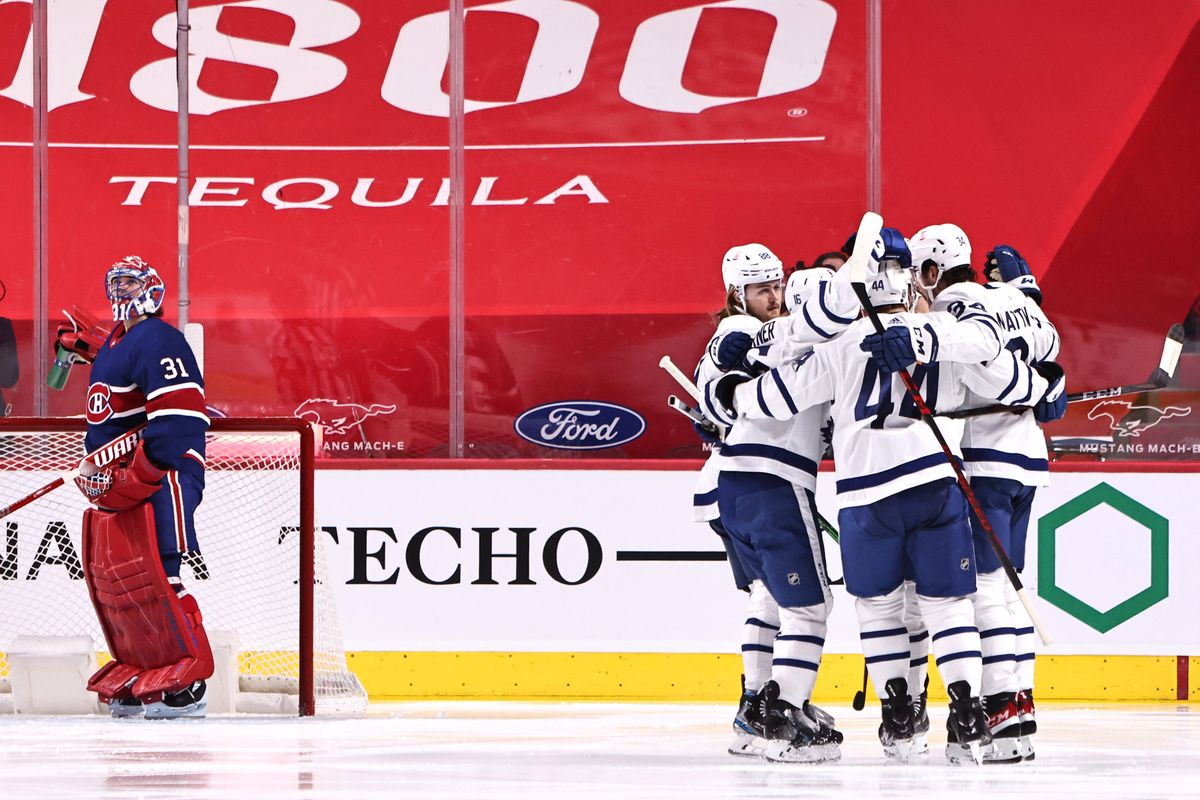
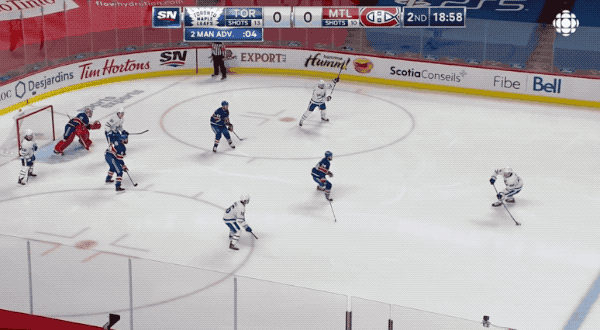
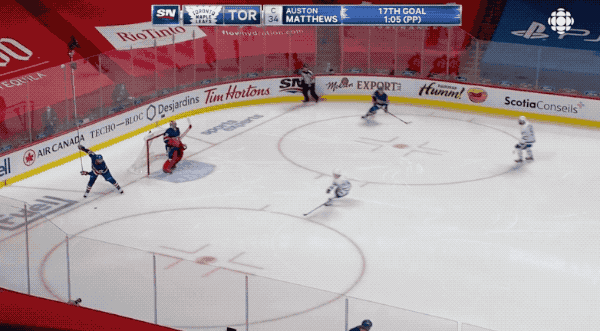
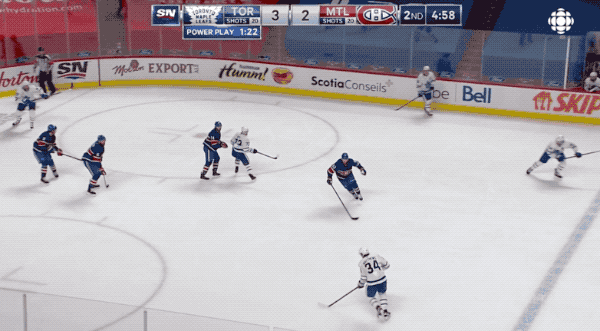
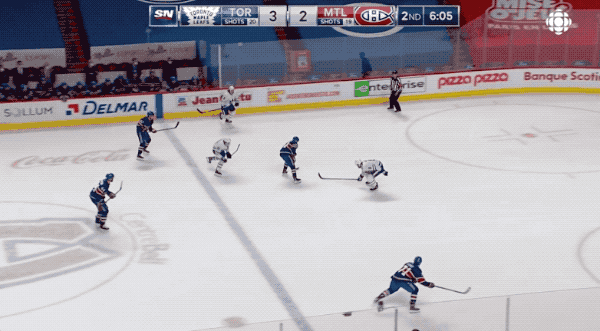
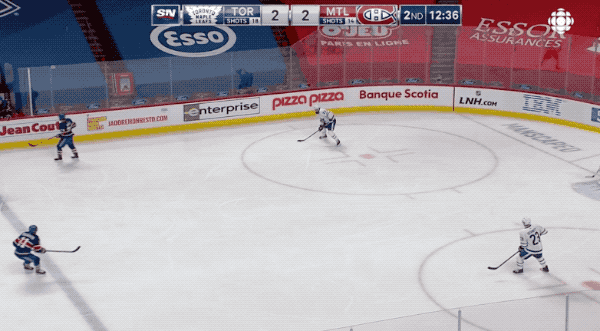
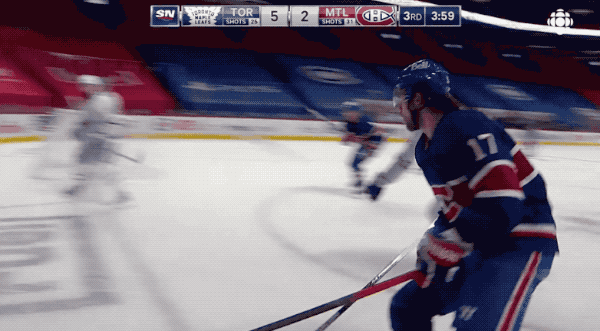
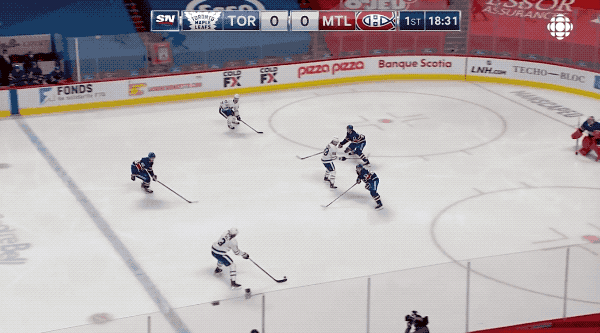
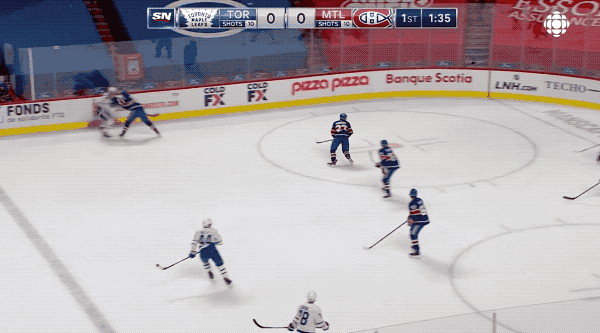
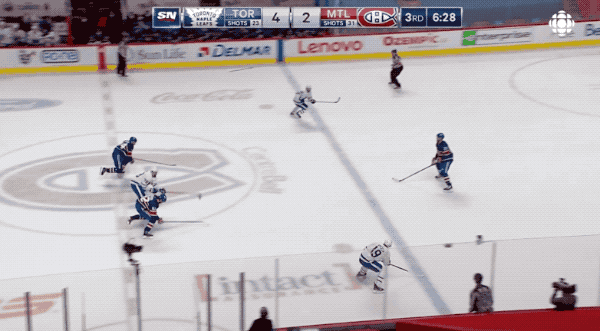
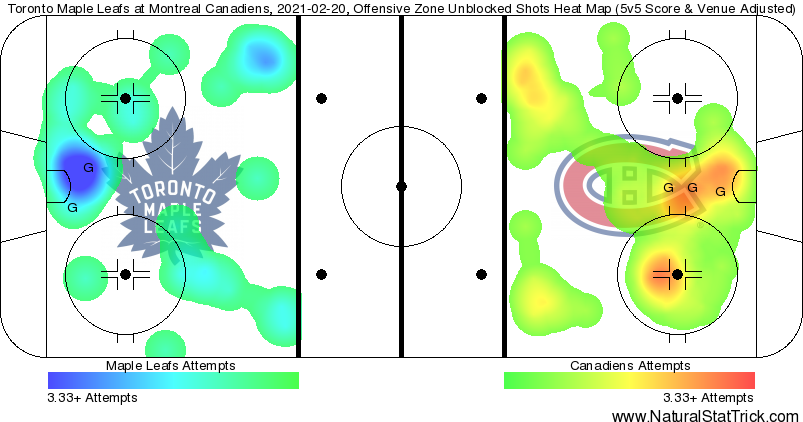
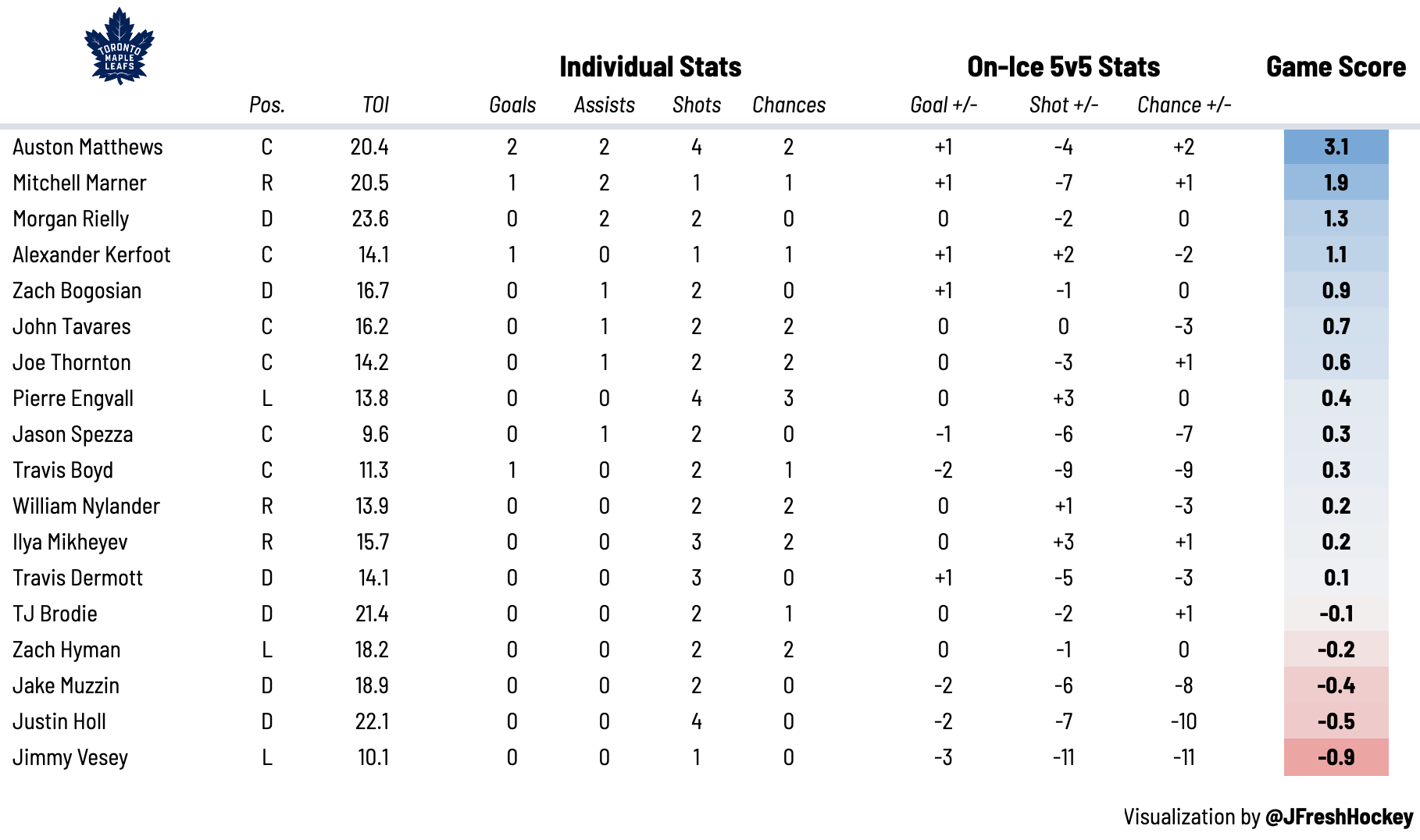











![New Leaf Anthony Stolarz on the opportunity in Toronto: “In Florida, I knew my role as a backup… Now, [Joseph Woll] and I are competing for starts… As a goalie, that’s all you can ask for” Anthony Stolarz, Stanley Cup win, now Maple Leaf](https://mapleleafshotstove.com/wp-content/uploads/2024/07/anthony-stolarz-sc-100x70.jpg)
